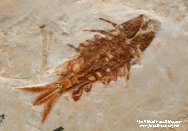Cf Protoligoneura
limai Class
Insecta: Insect Order Ephemeroptera
Geological
Time: Lower Cretaceous, Late Aptian-Cenomanian (108-92 million years
ago)
Size: 20
mm
Fossil
Site: Crato Formation, Nova Olinda Member, Ceara, Brazil
 The
Araripe Basin of Brazil is home to a fantastic array of exquisitely-detailed
Early Cretaceous fossils, some of which have been preserved in three
dimensions. While the entire formation has until the last decade
or so been termed the Santana Formation, David Martill has separated
out the slightly older insect-bearing strata as the Nova Olinda
Member of the Crato Formation. Quarrying operations for the purposes
of obtaining paving stones exposes the remarkable insect fauna in
much the same way that quarrying for lithographic limestone in Solnhofen
has afforded a panoply of wonderfully-preserved Jurassic fossils
in Germany. In addition to the many orders of insects, spiders,
scorpions, decapod crustaceans, and many plants have been found.
Interestingly, to date no pterosaurs or terrestrial vertebrates
have been found, in stark contrast to the overlying Santana Formation
deposits. This fine example shows a mayfly naiad (nymph) in ventral
view. The Ephemroptera arose during the Permian. The name refers
to the ephemeral existence of adults who live for a few hours to
a few days post-emergence. Note the preserved limbs and feathery
gills; preserved as well are the tripartite terminal filaments which
had a role in propulsion. The
Araripe Basin of Brazil is home to a fantastic array of exquisitely-detailed
Early Cretaceous fossils, some of which have been preserved in three
dimensions. While the entire formation has until the last decade
or so been termed the Santana Formation, David Martill has separated
out the slightly older insect-bearing strata as the Nova Olinda
Member of the Crato Formation. Quarrying operations for the purposes
of obtaining paving stones exposes the remarkable insect fauna in
much the same way that quarrying for lithographic limestone in Solnhofen
has afforded a panoply of wonderfully-preserved Jurassic fossils
in Germany. In addition to the many orders of insects, spiders,
scorpions, decapod crustaceans, and many plants have been found.
Interestingly, to date no pterosaurs or terrestrial vertebrates
have been found, in stark contrast to the overlying Santana Formation
deposits. This fine example shows a mayfly naiad (nymph) in ventral
view. The Ephemroptera arose during the Permian. The name refers
to the ephemeral existence of adults who live for a few hours to
a few days post-emergence. Note the preserved limbs and feathery
gills; preserved as well are the tripartite terminal filaments which
had a role in propulsion.
|
|